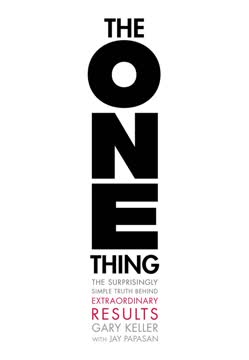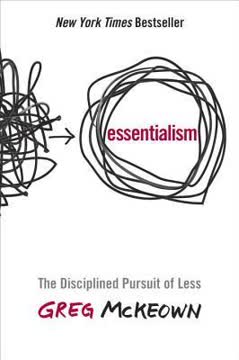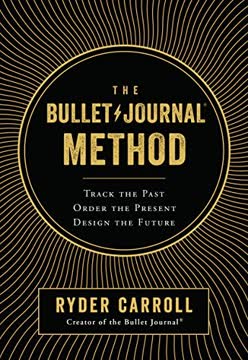Key Takeaways
1. Capture everything that has your attention
Your mind is for having ideas, not holding them.
Collect all inputs. Gather every task, idea, or commitment that's on your mind into a trusted external system. This includes work and personal items, from major projects to small errands. Use physical in-trays, notepads, or digital tools like smartphone apps to capture these inputs as they occur.
Create capture habits. Make it a habit to write down or record anything that has your attention immediately. This frees up mental space and ensures nothing falls through the cracks. Keep capture tools readily available in all contexts – at your desk, in your bag, and on your devices.
- Physical capture tools: In-tray, notebook, index cards
- Digital capture tools: Notes app, voice memos, email to self
- Capture locations: Work, home, on-the-go
2. Clarify what each item means and what to do about it
Clarifying, getting your "In" to empty, doesn't mean actually doing all those things. It just means identifying each item and deciding what it is and where it goes.
Process your inputs. Regularly go through your captured items and decide what each one means and what action, if any, it requires. This clarification step transforms vague ideas into concrete next actions or filed reference material.
Use the Clarifying process. For each item, ask:
- What is it?
- Is it actionable?
- If yes, what's the next action?
- If no, is it trash, reference, or something to incubate?
This systematic approach ensures every item is properly categorized and nothing remains in an ambiguous state.
3. Organize your actions into a trusted system
Being organized simply means that where something is matches what it means to you.
Create clear categories. Establish distinct lists and folders for different types of items:
- Next Actions: Immediate, single-step tasks
- Projects: Multi-step outcomes
- Waiting For: Items delegated to others
- Someday/Maybe: Ideas for the future
- Reference: Non-actionable information
Use appropriate tools. Choose organizational tools that work for you, whether digital or analog. The key is consistency and ease of use. Avoid overly complex systems that you won't maintain.
- Digital options: Task management apps, note-taking software
- Analog options: Paper planner, file folders, index cards
- Hybrid approach: Combine digital and physical systems as needed
4. Reflect regularly on your commitments
Do something about what you're thinking, and think about what you're doing.
Review your system. Regularly assess your lists, projects, and calendar to ensure they're up-to-date and aligned with your current priorities. This reflection keeps you in control and aware of your commitments.
Implement a review routine. Schedule time for daily, weekly, and periodic reviews:
- Daily: Quick scan of calendar and critical next actions
- Weekly: Comprehensive review of all lists and projects
- Monthly/Quarterly: Higher-level review of goals and long-term projects
These reviews help you stay on top of your commitments and make necessary adjustments.
5. Engage with your tasks confidently
Do. Or do not. There is no try.
Trust your system. Once you've captured, clarified, and organized your commitments, you can engage with your tasks confidently. Your external system allows you to focus on the task at hand without worrying about forgetting other obligations.
Choose tasks contextually. Select your next actions based on:
- Context (location, tools available)
- Time available
- Energy level
- Priority
This flexible approach allows you to be productive in various situations, making the most of your time and resources.
6. Create a Projects list to track multi-step outcomes
Some people have lists of big goals and visions, and many people have lists of simple to-dos. Very few have a list of all the in-between outcomes (i.e., "projects"), and that's a critical list for staying focused on the right stuff, week to week.
Define projects clearly. A project is any outcome requiring more than one action step. Maintain a comprehensive list of all your current projects, both personal and professional.
Review and update regularly. Ensure each project has:
- A clear, actionable outcome
- At least one next action identified
- Regular review to maintain progress
This approach prevents projects from stalling and keeps you aware of all your commitments.
7. Conduct a Weekly Review to stay on top of your system
The Weekly Review is the single most important move for consistent GTD practice. If you do it, your system will live and grow more mature and meaningful. If you don't, your practice will diminish and eventually fall away.
Schedule dedicated review time. Set aside 30-90 minutes each week for a comprehensive review of your system. Choose a consistent time and place to make it a habit.
Follow a structured process:
- Get Clear: Collect loose papers, process inboxes, empty your head
- Get Current: Review next actions, calendar, projects, and waiting for items
- Get Creative: Review someday/maybe list, generate new ideas
This weekly habit ensures your system remains current and trustworthy.
8. Use the Two-Minute Rule for quick tasks
If a next action can be done in two minutes or less, do it now.
Handle small tasks immediately. When processing your inputs, if an action takes less than two minutes, do it on the spot rather than deferring it. This prevents small tasks from accumulating and clogging your system.
Examples of two-minute tasks:
- Responding to a quick email
- Making a brief phone call
- Filing a document
- Adding an item to your shopping list
This rule increases overall efficiency by promptly clearing minor tasks.
9. Keep your calendar sacred for time-specific commitments
Consider your calendar to be the "hard landscape" of your day, the things that have to be done on a certain day, including meetings, deadlines, and day-specific events—the things you have to do, not things that you want to try to do.
Reserve your calendar for true time commitments. Use your calendar only for:
- Appointments and meetings
- Day-specific deadlines
- Time-sensitive information
Avoid putting regular to-dos or wishful thinking items on your calendar. This maintains its integrity as a trusted tool for time-specific obligations.
Use other lists for non-time-specific tasks. Keep your next actions and project-related tasks on separate lists, not on your calendar. This separation allows for more flexibility in your day-to-day work.
10. Empty your in-tray and inbox regularly
If you don't pay attention to what has your attention, it will take more of your attention than it deserves.
Process to zero regularly. Aim to empty your physical in-tray and email inbox daily or every few days. This prevents backlogs and ensures you're always aware of and acting on your current inputs.
Follow the clarify process for each item:
- Decide what it is and what needs to be done
- Take immediate action, delegate, or defer as appropriate
- File reference materials
- Delete or archive completed items
Regular processing maintains the flow of your system and prevents overwhelm from accumulated inputs.
Last updated:
FAQ
What's "The Getting Things Done Workbook" about?
- Overview: "The Getting Things Done Workbook" by David Allen and Brandon Hall is a practical guide designed to help individuals achieve stress-free productivity through a series of structured exercises.
- Purpose: It serves as a supplement to Allen's original "Getting Things Done" book, focusing on actionable steps to implement the GTD methodology.
- Structure: The workbook is organized into ten moves, each aimed at enhancing personal and organizational productivity by managing tasks, projects, and commitments effectively.
- Authors' Expertise: David Allen is renowned for his expertise in productivity, while Brandon Hall brings experience in coaching and high achievement strategies.
Why should I read "The Getting Things Done Workbook"?
- Practical Application: The workbook provides hands-on exercises that help you apply the GTD methodology in real-life scenarios, making it easier to adopt and maintain.
- Stress Reduction: By following the workbook's steps, you can achieve a state of stress-free productivity, allowing you to focus on what truly matters.
- Improved Organization: It offers a structured approach to organizing tasks, projects, and commitments, leading to better time management and efficiency.
- Expert Guidance: With insights from productivity expert David Allen, the workbook is a reliable resource for anyone looking to enhance their productivity skills.
What are the key takeaways of "The Getting Things Done Workbook"?
- Five Steps of GTD: The workbook emphasizes the five steps of the GTD methodology: Capture, Clarify, Organize, Reflect, and Engage.
- Ten Moves: It breaks down the GTD process into ten actionable moves, each designed to help you implement the methodology effectively.
- Mind Like Water: Achieving a "Mind Like Water" state is a key goal, where your mind is clear and focused, allowing for optimal productivity.
- Regular Reviews: The importance of weekly and daily reviews is highlighted to maintain control over tasks and commitments.
How does the GTD methodology work in "The Getting Things Done Workbook"?
- Capture: Collect all tasks, ideas, and commitments in a trusted system to ensure nothing is forgotten.
- Clarify: Process each item to determine the next action required, whether it's actionable or not.
- Organize: Place items in appropriate categories such as Next Actions, Waiting For, or Someday/Maybe lists.
- Reflect and Engage: Regularly review your lists and commitments to stay on top of your tasks and make informed decisions about what to work on next.
What is the "Mind Like Water" concept in "The Getting Things Done Workbook"?
- State of Clarity: "Mind Like Water" refers to a state of mental clarity where your mind is free from distractions and able to focus on the task at hand.
- Responsive, Not Reactive: It emphasizes being responsive to tasks and challenges rather than reacting impulsively, much like water that adapts to its environment.
- Achieving Balance: The concept encourages balance and calmness, allowing you to handle tasks with ease and efficiency.
- GTD Goal: Achieving this state is a primary goal of the GTD methodology, as it leads to enhanced productivity and reduced stress.
What are the ten moves to stress-free productivity in "The Getting Things Done Workbook"?
- Capture Moves: Include capturing all incoming paper into one in-tray, choosing a capture tool, and doing a mind sweep.
- Clarify Moves: Focus on getting your in-tray to empty and getting your emails to zero.
- Organize Moves: Involve creating next actions and other lists, keeping track of projects on one list, and creating folders to stay organized.
- Reflect & Engage Moves: Include doing a GTD Weekly Review and conducting a daily review to maintain productivity.
How can I implement the GTD Weekly Review from "The Getting Things Done Workbook"?
- Regular Schedule: Choose a regular time and place for your weekly review, ideally when you can focus without interruptions.
- Checklist: Use the GTD Weekly Review Checklist to guide you through the process, ensuring you cover all necessary areas.
- Get Clear: Collect loose papers, get your in-tray to zero, and empty your head of uncaptured items.
- Get Current and Creative: Review your lists, calendar, and projects, and be open to new ideas and adjustments.
What tools and supplies are recommended in "The Getting Things Done Workbook"?
- In-Trays: Use two in-trays, one for work and one for personal use, to capture all incoming paper.
- Capture Tools: Choose between digital tools like smartphones or traditional pen and paper for capturing tasks and ideas.
- Folders and Labels: Set up paper and digital folders for organizing reference materials, projects, and support documents.
- Label Maker: A label maker is recommended for creating clear and consistent labels for your folders.
How does "The Getting Things Done Workbook" suggest handling email?
- Inbox to Zero: Aim to get your email inbox to zero by processing each email and placing it in the appropriate folder.
- Email Folders: Create folders such as Next Actions, Waiting For, Someday/Maybe, and Reference to organize emails.
- Two-Minute Rule: Apply the two-minute rule to handle quick actions immediately, reducing the number of emails to process later.
- Regular Review: Regularly review and process emails to maintain control and prevent backlog.
What are some best quotes from "The Getting Things Done Workbook" and what do they mean?
- "Your mind is for having ideas, not for holding them." This quote emphasizes the importance of capturing ideas and tasks in a trusted system to free your mind for creative thinking.
- "If you don’t pay attention to what has your attention, it will take more of your attention than it deserves." It highlights the need to address tasks and commitments to prevent them from becoming distractions.
- "The way to get anything under control...is to capture, clarify, organize, reflect, and engage with it." This quote summarizes the GTD methodology's approach to managing tasks and achieving productivity.
- "Be steady and well-ordered in your life so that you can be fierce and original in your work." It suggests that organization and orderliness in personal life lead to creativity and effectiveness in professional endeavors.
How can I track my progress using "The Getting Things Done Workbook"?
- Progress Tracker: The workbook includes a progress tracker to record the completion of each of the ten moves.
- Regular Updates: Regularly update the tracker to monitor your progress and stay motivated.
- Reflect on Improvements: Use the tracker to reflect on improvements in productivity and stress levels as you implement the GTD methodology.
- Reassess: Reassess your current reality using the self-assessment provided in the workbook to measure your growth.
What resources are available for further learning about GTD after "The Getting Things Done Workbook"?
- Books: Explore other books by David Allen for a deeper understanding of the GTD methodology.
- GTD Connect: Join GTD Connect, a membership-based resource center offering webinars, audio, and video content.
- Podcasts: Listen to GTD podcasts available on platforms like iTunes, Stitcher, and Spotify for ongoing learning and insights.
- Workshops and Coaching: Attend workshops and seek coaching services to enhance your GTD practice and achieve mastery.
Review Summary
The Getting Things Done Workbook receives mixed reviews, with an average rating of 4.10. Positive reviews praise its practical approach, simplified explanations, and step-by-step guidance for implementing the GTD system. Critics appreciate its condensed format compared to the original book. However, some reviewers find the design cluttered with unnecessary graphics and wasted space. The workbook is seen as helpful for both GTD beginners and experienced practitioners, offering a more accessible introduction to the methodology. Despite criticisms of execution, many readers find value in its content for improving productivity and organization.
Similar Books










Download PDF
Download EPUB
.epub digital book format is ideal for reading ebooks on phones, tablets, and e-readers.








